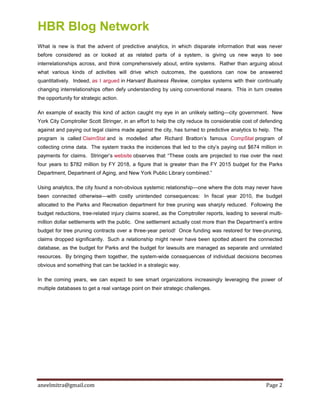Trust databases to manage the complexity you can't
- 1. HBR Blog Network aneelmitra@gmail.com Page 1 To Make Better Decisions, Combine Datasets by Rita McGrath A complicated system is somewhat like a complicated recipe. You know what the outcome will be because you understand what will cause what — combine a given number of ingredients together in a certain way, put them in the oven, and the results will be consistent as long as you repeat the same procedure each time. In a complex system, however, elements can potentially interact in different ways each time because they are interdependent. Take the airline control system—the outcomes it delivers vary tremendously by weather, equipment availability, time of day, and so on. So being able to predict how increasingly complex systems (as opposed to merely complicated systems) interact with each other is an alluring premise. Predictive analytics increasingly allow us to expand the range of interrelationships we can understand. This in turn gives us a better vantage point into the behavior of the whole system, in turn enabling better strategic decision-making. This idea is not new, of course. Firms have been developing models that predict how their customers will behave for years. Companies have developed models that indicate which customers are likely to defect, what advertising pitches they will respond to, how likely a debtor is to default (and what can be done to avoid making loans to that person), what will prompt donors to up the ante on their giving, and even who is likely to pay more for services like car insurance. Organizations such as Blue Cross Blue Shield have used their considerable databases about chronically ill people to target and influence their care, reducing to some extent the total cost of care, much of which is concentrated in helping a small portion of their total consumer base.
- 2. HBR Blog Network aneelmitra@gmail.com Page 2 What is new is that the advent of predictive analytics, in which disparate information that was never before considered as or looked at as related parts of a system, is giving us new ways to see interrelationships across, and think comprehensively about, entire systems. Rather than arguing about what various kinds of activities will drive which outcomes, the questions can now be answered quantitatively. Indeed, as I argued in Harvard Business Review, complex systems with their continually changing interrelationships often defy understanding by using conventional means. This in turn creates the opportunity for strategic action. An example of exactly this kind of action caught my eye in an unlikely setting—city government. New York City Comptroller Scott Stringer, in an effort to help the city reduce its considerable cost of defending against and paying out legal claims made against the city, has turned to predictive analytics to help. The program is called ClaimStat and is modelled after Richard Bratton’s famous CompStat program of collecting crime data. The system tracks the incidences that led to the city’s paying out $674 million in payments for claims. Stringer’s website observes that “These costs are projected to rise over the next four years to $782 million by FY 2018, a figure that is greater than the FY 2015 budget for the Parks Department, Department of Aging, and New York Public Library combined.” Using analytics, the city found a non-obvious systemic relationship—one where the dots may never have been connected otherwise—with costly unintended consequences: In fiscal year 2010, the budget allocated to the Parks and Recreation department for tree pruning was sharply reduced. Following the budget reductions, tree-related injury claims soared, as the Comptroller reports, leading to several multi- million dollar settlements with the public. One settlement actually cost more than the Department’s entire budget for tree pruning contracts over a three-year period! Once funding was restored for tree-pruning, claims dropped significantly. Such a relationship might never have been spotted absent the connected database, as the budget for Parks and the budget for lawsuits are managed as separate and unrelated resources. By bringing them together, the system-wide consequences of individual decisions becomes obvious and something that can be tackled in a strategic way. In the coming years, we can expect to see smart organizations increasingly leveraging the power of multiple databases to get a real vantage point on their strategic challenges.


